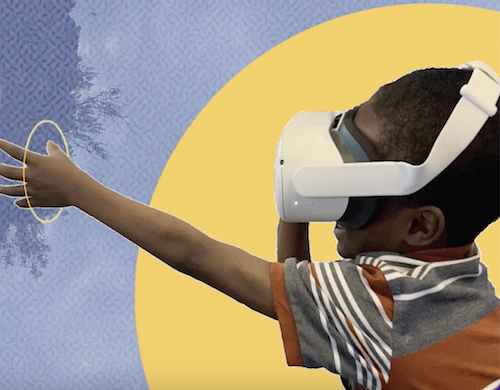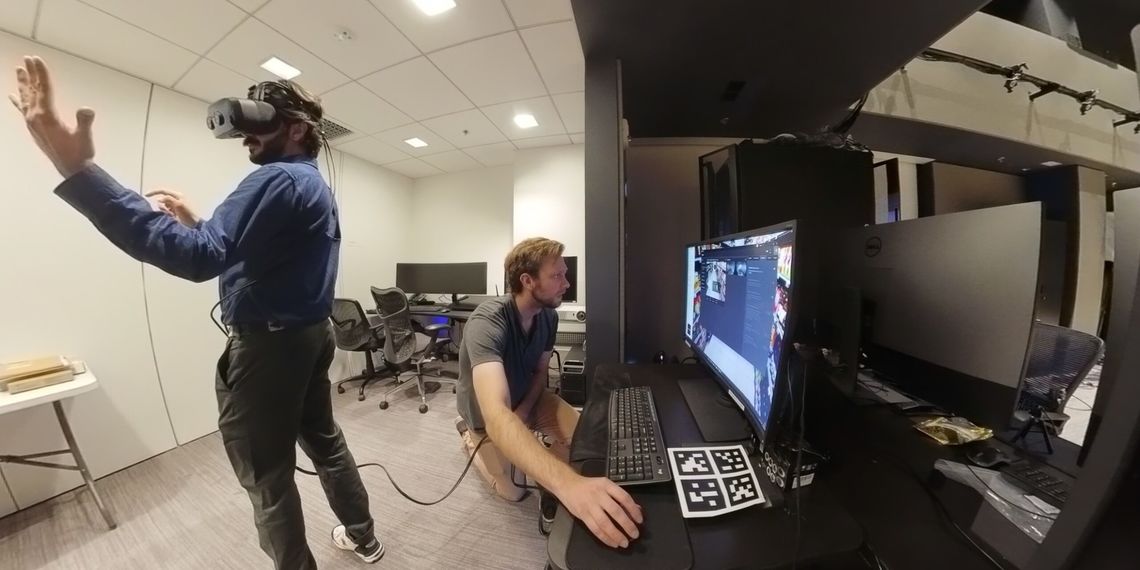Bridging the Gap

Learn more about how Bridging the Gap is addressing the needs of displaced populations.
or many years, we’ve worked with the International Rescue Committee to hold workshops with new Americans who are new to Salt Lake City and were formerly refugees. These workshops help improve digital literacy while giving newcomers a chance to learn more about how to settle into the community.
In 2020, as the COVID-19 pandemic began, we sought out new ways to connect with immigrants and former refugees who are resettling in Utah. Because the pandemic really limited our human contact, we had to use technology to remotely help people. That’s when we began using virtual reality (VR) technology and partnering with Massachusetts Institute of Technology (MIT) to make this technology a sustainable resource for our new American community.
A virtual introduction to the community
How can VR technology help newcomers?
Milad Mozari: Through VR technology, we help newcomers see how the community works. For instance, we began by showing them how to navigate the school system and how to get to school on a bus. These video modules help our clients experience new things at their own pace, in the comfort of their homes. As the project continues, we are finding new subjects that clients are interested in, including how to get medical care.
How did the project get into the healthcare field?
MM: Dr. Julie Day, former Medical Director at the Redwood Health Center, really showed me how newcomers were struggling to access the healthcare they needed. Through our conversations, she emphasized how important this project could be to her patients and how it could address their needs. We were able to film in her health center, creating a VR workshop that explains how to navigate the health center more clearly.
Responding to client feedback
How do you ensure you are incorporating feedback into the project?
MM: Every time we use the VR with clients, we do assessments, asking questions such as:
-
What was your comfort level?
-
What did you see?
-
What else do you want to see or know?
These questions help us understand how different genders and different cultures feel about this technology. Requesting their feedback also helps our clients own part of the project. They must be part of the project, helping us identify and work through problems, in order to help them as best we can.
Many projects can start out for the right reasons, but then leave behind the population it was meant to serve. By having our clients involved in the project, we hope to continue to scale the project while keeping new Americans centered. We use mentorship to help new Americans become involved in the tech industry and emerging technologies so they can serve as leaders and as voices for their community.
Their feedback and voice is vital to keeping our project going strong.
How can healthcare providers serve new Americans?
MM: Through working with the Redwood Health Center and its patients, we are learning more about how healthcare providers can offer better care to immigrants and marginalized communities. First, we encourage all healthcare providers to remember that these communities have a wide range of education. It’s important to take time to see that intelligence and meet patients where they are at, even if you can’t speak the same language.
We also encourage providers to become advocates for the local former refugee community. It can be extremely difficult for our clients to access health, vision and dental care. We need more providers within the community to speak up and to find ways to increase access to care for our new American community.
What is in store for the future of VR in refugee resettlement?
MM: There are an endless number of things new Americans need to know as they settle into a new community. As we continue the project, we are looking to create modules on a number of different topics, such as:
-
How to interact with a clinician and care team
-
How to get X-rays or imaging
-
Information on legal matters in the U.S.
-
Navigating the DMV
-
Therapeutics through VR
We are also looking at other types of emerging technology and how that could help the new American community. For instance, we are looking at smart devices and augment reality overlays and the ways they could help make resettlement easier.
Furthermore, the IRC is very interested in expanding and scaling up this project across the country. We are working to meet with other regional offices, to show them how this project works and how the technology can help their clients.
As we expand in so many different ways, we have to keep our new American community centered. We have to work as a team, work through discussions, to ensure we are truly being helpful. This project is not the result of one person’s work; it is a work of innovation within the community. Our project cannot grow well, or at all, without the help of newcomers, programmers, healthcare providers, community leaders and more.
Together, we can move forward to provide a warmer welcome to Utah and give new Americans the support they critically need.
Experience the VR tech
Milad Mozari
Director of community engagement RyLee Curtis shares how we’re partnering with communities to build a new learning and health campus, and what we can apply now, even before construction starts
Well-being specialist Trinh Mai started BIPOC (Black, Indigenous, People of color) Check-in & Support via Zoom as a place to grieve and honor George Floyd and process ongoing racism. This is a space for employees at the U who self-identify as BIPOC to experience community, share struggles and solutions, and celebrate being who they are. Trinh and some members of the check in group share how the group started, how it has evolved and its lasting impacts.
Join the University of Utah community as we celebrate and honor Juneteenth. Here are a list of Juneteenth celebrations and events on campus and in the surrounding community, as well as suggested readings and resources.
